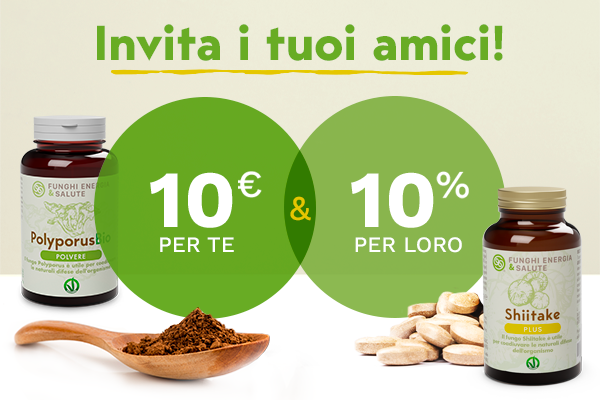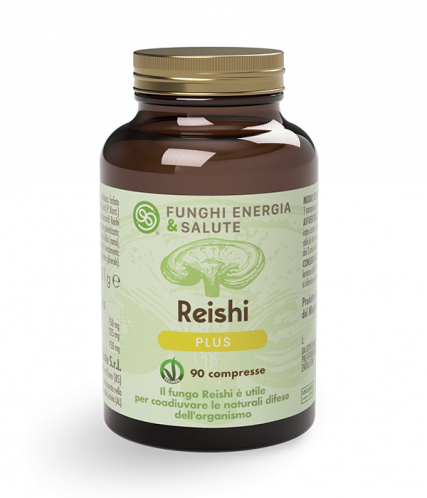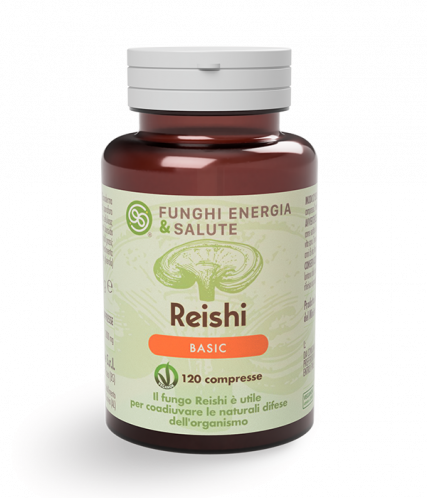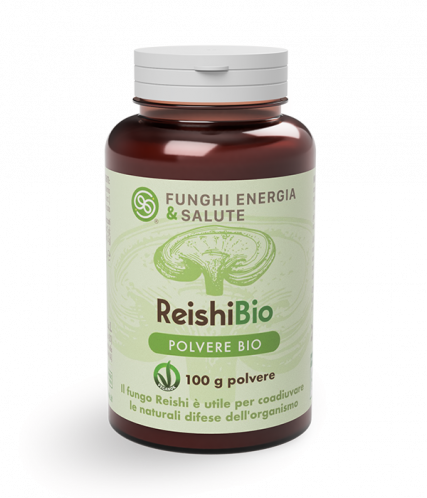Certified Natural products veganOK
030 9881073 Monday to Friday from 09:00 to 17:30
Toggle Nav 



Skip to Content
Language
EN
How can we help you?
Search
Subscribe to the Newsletter
to get immediately a discount code
on your first purchase
to get immediately a discount code
on your first purchase
Reishi
- Home
- Reishi
Reishi
In modern times
Reishi (Ganoderma lucidum) is a highly appreciated Medicinal Mushroom. Its beneficial effects have been confirmed scientifically over the last fifty years thanks to hundreds of studies. In fact, from the universities of Japan and China it has become well-known in Europe and the United States.
Reishi boosts the immune system and fights viruses and bacteria (Wasser, 2005). It acts as a cortison-like anti-inflammatory agent, without determining the typical side effects of this drug, thanks to a different mechanism of action (Stavinoha et al., 1991 e 1995).
It is also useful in different forms of allergy, as emerges from the work of Dr. Powell, an English doctor, (Powell, 2006; Sanodiya et al., 2009) and is an excellent gastroprotector, as confirmed by other researchers.
Another study confirmed the presence of at least four substances, triterpenoids, which protect the liver (Lin et al., 2002); ganoderic acids R and S and ganosporeric acid A have been shown to increase the activity of liver enzymes (Chen and Yu, 1993; Wang et al., 2002).
Reishi reduces anxiety, improves sleep (Wang et al., 2001) and lightens the pressures of everyday life, improving mood and vitality (Tang et al., 2005).
This Medicinal Mushroom also helps the neurological structure of the brain’s memory centres (Zhou et al., 2012) and has excellent cardiotonic properties. It increases the energy yield of the heart and thanks to adenosine it improves blood circulation throughout the body (Berne, 1980; Toda et al., 1982). Finally, Reishi promotes female sexual functions, as documented by some studies (Shimizu et al., 2009) and is increasingly being added to the ingredients of beauty products. Not surprisingly, in the East, women have always used it as part of their beauty routine.
Ancient tradition
Reishi has been used in Traditional Chinese Medicine for over 4000 years, so much so that it appears in the oldest manual of Chinese medicine dating back to 2800 BC - "Shen Nong Ben Cao Jing", the "Divine Farmer's Materia Medica". The guide places it among the ten most important "high class" remedies, thanks to its wealth of benefits and absence of side effects.
Throughout traditional Chinese pharmacopoeia, Reishi is appreciated because it tones up psychophysical energy, and that of the blood and the heart.
It is also able to nourish and strengthen all organs, eliminate the accumulation of toxins and expectorate mucus and cough. As regards psychological balance, Reishi was used to increase concentration, sharpen intelligence, improve memory, strengthen willpower and relax disturbed minds.
Reishi is not present only in the practices of Traditional Oriental Medicine: some research has shown that this Medicinal Mushroom is extremely important also in Mexican Popular Medicine. The indigenous peoples of South America, in fact, used it to treat many illnesses, in particular heart diseases but also as a natural product useful for ensuring multiple benefits.
Mycology
Reishi (Ganoderma lucidum) means "mushroom of immortality" and in Eastern art and popular tradition it symbolizes well-being and luck, a bit like the four-leaf clover in the Western world.
This Medicinal Mushroom belongs to the saprophyte family and grows wild in Asia, but also in many other areas of the world, such as European woods.
Thanks to its exceptional immune defences, it manages to survive in hostile environments, full of germs and viruses, which is why it also has excellent properties against pathogenic germs in humans.
Chemical compounds
Reishi is one of the Medicinal Mushrooms richest in biological properties: there are about 400. Their presence or deficiency significantly affects the metabolic balance of the body (Baby et al., 2015; Sanodiya et al., 2009).
In Reishi there are several active ingredients, in particular:
- some beta-glucans that stimulate the immune system against viruses and bacteria. Other beta-glucans reduce high cholesterol and triglycerides; still others function as hepatoprotectors or as hypoglycemic agents (ganoderans B and D);
- more than 130 triterpenes (almost all ganoderic acids), which have many interesting effects. Among them, it is worth mentioning:
- a cortison-like anti-inflammatory (Stavinoha et al., 1991 e 1995) of efficacy equal to diclofenac (Voltaren) (Joseph et al., 2009),
- 5 antihistamines (ganoderic acid C1, C2 and D) (Kohoda et al., 1985), including cyclooctasulfur and oleic acid,
- 4 antiviral substances: ganoderiol F and ganodermanontriol (El-Mekkawy et al., 1998), lucidumol-B and ganodermanontriol (Min et al., 1998),
- various pain relieving molecules, such as ganoderic acid A, B, G and compound C6 (Koyama et al., 1997),
- anti-inflammatory substances, such as ganoderiol F, ganodermanondiol and ganodermanontriol (Min et al., 2001),
- ganoderic acid B and C, which reduces high cholesterol (Sonoda et al., 1988; Komoda et al., 1997);
- adenosine, an excellent vasodilator that improves blood circulation throughout the body (Berne, 1980; Toda et al., 1982; Pelleg and Porter, 1990). It reduces anxiety and is an effective anti-inflammatory agent and relaxes the muscles (Akkari et al., 2006);
- cytochrome P-450 (CYP450) is a group of liver enzymes. It represents the main detoxification mechanism of the body against external (such as alcohol, chemicals and drugs) and internal (body's waste products) agents. It is probably the most advanced purification system in nature, present in mammals and fungi;
- antioxidant substances, which counteract the harmful action of free radicals, molecules responsible for premature aging of cells and tissues and the cause of chronic and degenerative diseases;
- tyrosinase, an enzyme that modulates the production of melanin and promotes the elimination of skin marks (Chien et al., 2008);
- LZ-8, a protein useful in allergies;
- prebiotics, which nourish healthy intestinal bacterial flora;
- glucomannan, a vegetable fibre that tends to give a feeling of satiety;
- B vitamins and vitamin D2, which remineralizes bones and teeth;
- macro-minerals, such as magnesium, potassium, calcium, phosphorus, iron;
- trace minerals, especially germanium – that invigorates and provides energy, zinc and selenium, an excellent antioxidant.
Bibliography
- Akkari R, Burbiel JC, Hockemeyer J, Muller CE. (2006): “Recent progress in the development of adenosine receptor ligands as antiinflammatory drugs.” Current Topics in Medicinal Chemistry, 6(13): 1375-1399.
- Baby S, Johnson AJ, Govindan B. (2015): “Secondary metabolites from Reishi.” Phytochemistry, 114: 66-101.
- Berne RM. (1980): “The role of Adenosine in the regulation of coronary blood flow.” Circ. Res. 47: 807-813.
- Chen RY, Yu DQ. (1993): “Studies on the triterpenoid constituents of the spores from Ganoderma lucidum Karst.” J. Chin. Pharm. Sci., 2: 91-96. • Chien CC, Tsai ML, Chen CC, Chang SJ, Tseng, CH. (2008): “Effects on tyrosinase activity by the extracts of Ganoderma lucidum and related mush- rooms.” Mycopathologia, 166(2): 117-120.
- El-Mekkawy S, Meselhy MR, Nakamura N, Tezuka Y, Hattori M, Kakiuchi N, Shimotohno K, Kawahata T, Otake T. (1998): “Anti-HIV-1 and anti- HIV-1-protease substances from Ganoderma lucidum.” Phytochemistry, 49: 1651- 1657.
- Gao YH, Zhou SF, Wen JB, Huang M, Xu A. (2002): “Mechanism of the antiulcerogenic effect of Ganoderma lucidum polysaccharides on indomethacin-induced lesions in the rat.” Life Science, 72: 731-45.
- Gao YH, Tang W, Gao H, Chan E, Lan J, Zhou SF. (2004): “Ganoderma lucidum polysaccharide fractions accelerate healing of acetic acid-induced ulcers in rats.” Journal of Medicinal Food, 7(4): 417-21.
- Joseph S, Baby S, Varughese G, Thozhuthumparambal PS, Kai-noor J. (2009): “Antioxidative and antiinflammatory activities of the chloroform ex- tract of Ganoderma lucidum found in South India.” Scienza Pharmaceutica, 77: 111-21.
- Kohoda H, Tokumoto W, Sakamoto K, Fujii M, Hirai Y, Yamasaki K, Komoda Y, Nakamura H, Ishihara S, Uchida M. (1985): The biologically active constituents of Ganoderma lucidum (Fr.) Karst. histamine release-inhibitory triterpenes. Chem. Pharm. Bull., 33: 1367-1374.
- Koyama K, Imaizumi T, Akiba M, Kinoshita K, Takahashi K, Suzuki A, Yano S, Horie S, Watanabe K, Naoi Y. (1997): “Antinociceptive components of Ganoderma lucidum.” Planta Med., 63: 224-227.
- Min BS, Gao JJ, Hattori M, Lee HK, Kim YH. (2001): “Anticomplement Activity of Terpenoids from the Spores of Ganoderma lucidum.” Planta Med., 67: 811-14.
- Pelleg A, Porter RS. (1990): "The pharmacology of adenosine." Pharmacotherapy: The Journal of Human Pharmacology and Drug Therapy, 10(3): 157-174.
- Shimizu K, Miyamoto I, Liu J, Konishi F, Kumamoto S, Kondo R. (2009): “Estrogen-like activity of ethanol extract of Ganoderma lucidum.” Journal of Wood Science, 55(1): 53-59.
- Sonoda Y, Sekigawa Y, Sato Y. (1988): “In vitro effects of oxygenated lanosterol derivatives on cholesterol biosynthesis from 24, 25-dihydrolanosterol.” Chem. Pharm. Bull., 36: 966-973.
- Stavinoha W, Satsangi N, Weintraub S. (1995): “Study of the antiinflammatory efficacy of Ganoderma lucidum.” Kim BK, Kim YS. (Eds.): Recent Advances in Ganoderma lucidum research”, The Pharmaceutical Society of Korea, pp. 3-7.
- Stavinoha W, Slana J, Weintraub S, Mobley P. (1991): “The antiinflammatory activity of Ganoderma lucidum.” Third International Symposium on Ganoderma lucidum, pp. 9-21.
- Tang W, Gao Y, Chen G, Gao H, Dai X, Ye JY. (2005): “A Randomized, double-blind and placebo-controlled study of a Ganoderma lucidum polysaccharide extract (ganopoly) in neurasthenia.” Journal of Medicinal Food, 8: 53-58.
- Toda N, Okunishi H, Taniyama K, Miyazaki M. (1982): “Response to adenine nucleotides and related compounds of isolated dog cerebral, coronary and mesenteric arteries”, in Blood Vessels, 19, pp. 226-236.
- Wang MY, Liu Q, Che QM, Lin ZB. (2002): “Effects of total triterpenoids extract from Ganoderma lucidum (Curt.: Fr.) P. Karst. (Reishi Mushroom) on experimental liver injury models induced by carbon tetrachloride or d- galactosamine in mice.” International Journal of Medicinal Mushrooms, 4: 337- 342.
- Wang XL, Meng SY, Wang CP. (2001): “Clinical trials of Ganoderma lucidum on 60 patients suffered insomnia.” Zhongguo yi yao xue bao, Zhonghua quan guo Zhong yi xue hui zhu ban = Acta Medica Sinica, 16: 47-49.
- Wasser SP, (2005): “Reishi or Ling Zhi (Ganoderma lucidum).” Encyclopedia of Dietary Supplements.
- Zhou Y, Qu ZQ, Zeng YS, Lin YK, Li Y, Chung P, Wong R, Hägg U. (2012): “Neuroprotective effect of preadministration with Ganoderma lucidum spore on rat hippocampus”. Exp. Toxicol. Pathol., 64(7-8): 673-80.





